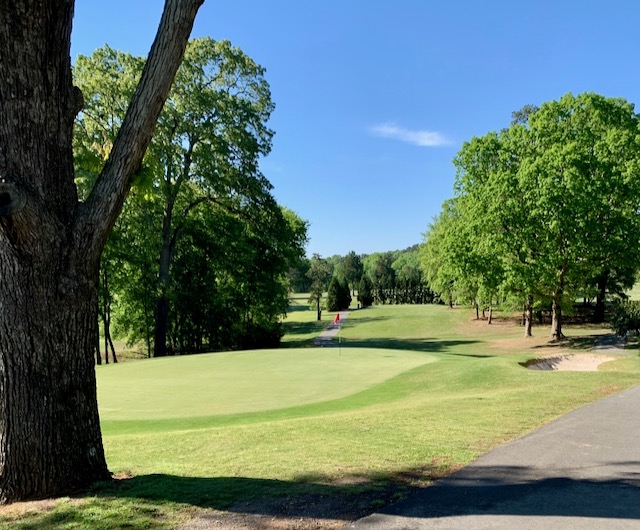With few exceptions, golf courses that have remained open the last two months across the nation have done a good job of adapting to play during the pandemic -- by closing pro shops and clubhouses and accepting green fee payment online only; by restricting cart use to one person or mandating walking only; by turning cups upside down or inserting raised foam edges to keep flags free from grabbing; and, most recently, by announcing the requirement to wear masks whenever there is a situation in which players are within the suggested social distance of six feet. Scorecards have also become a rarity.
Yet despite all these restrictions that golf purists surely -- however quietly -- hate, reports are that public courses are crowded across the country where the weather is good. Public layouts, by the way, account for 80% of all golf courses.
“Every day is Saturday morning,” friend and fellow blogger Brad Chambers wrote recently about Monroe Country Club near his home in Charlotte, NC. He has written a review of Monroe for my companion web site, OffTheBeatenCartPath.com. “When I checked in for my round, the golf pro told me they were completely full today (Friday), were full yesterday and were full all weekend.”
“Almost any industry you can name is struggling to stay solvent during the Coronavirus epidemic,” he added. “[But] not golf in North Carolina, nor in any other state that is allowing it to be played.”  Par 3 2nd hole at Monroe CC, Monroe, NC, designed by Donald Ross.
Par 3 2nd hole at Monroe CC, Monroe, NC, designed by Donald Ross.
Brad has been monitoring GolfNow, TeeOff and other sites in his state that offer discount rounds and, he wrote, “[the green fees] are $10 to $20 higher than I remember seeing them at any time, especially during the week.” (Note: Brad’s article at OffTheBeatenCartPath.com will be posted by Wednesday. In the meantime, you can read his other entertaining articles at ShootingYourAge.com, the web site he maintains.)
Brad's is, for sure, anecdotal evidence of the popularity of golf, but it provides something of an antidote to the continuous harping by the mainstream media about the death of golf. In the Wall Street Journal’s “Mansion” section on Friday, a front-page article argued that new-community developers have turned their backs on golf and are now including such amenities as community gardens instead. Some, as we read often, are plowing over their under-utilized golf courses and creating green spaces for walking and other essentially passive ventures (but only if local ordinances and covenants prevent construction of new homes).
I have no quibble with preserving green space in planned developments. We have 24 million golfers in the U.S. and the vast majority play on public golf courses not located inside the gates of traditional golf communities. And the many more millions who don’t play golf deserve the majority of space devoted to whatever they want to do – or not do, in the case of such leisurely activities as walking. I do object to the media’s contention that any of these reactions by developers is a signal of the demise of golf. There is no denying that, in anticipation of baby boomers reaching retirement age, developers saw golf as the ultimate lure for real estate sales. The result was more golf courses in the U.S. than was sustainable, especially in view of how the margins to operate a country club even in the best of times are incredibly thin. A pullback in the industry was inevitable. Golfers population is down from 30 million at its peak in 2003 to 24 million today.
But 24 million is still a huge number for any activity, and golf is by far more popular than other active sports like skiing (9 million) and tennis (fewer than 18 million). There is clear evidence from just before Covid-19 became an acknowledged crisis that golf was as popular as ever. According to the National Golf Foundation, golf rounds played in February were up 19.1% compared with February 2019; it is my own humble assumption that February rounds played in regions where Covid has had the most profound effects – the Northeast and Pacific Northwest, where rounds were up 99.6% and 52.2%, respectively – could translate into, “I gotta play before they shut things down.” (Check out the Golf Datatech map here.). Golfers are smarter than the average Joes, and they could see things coming that politicians and others couldn’t. (Okay, I’m a partisan when it comes to my fellow golfers.)
So intent were golfers on playing even after restrictions were in place that they literally put themselves in harm’s way. In Rhode Island, for example, three neighboring Massachusetts golfers dropped their car off just short of the RI border, threw their clubs in the back of a car with Rhode Island license plates, drove to a nearby golf course, ignored the warning signs that said “Rhode Island golfers only,” started play and then were arrested. Where local municipalities have closed courses, local players have shared their grievances in a more politically correct way, by signing petitions; in Palm Beach County, FL, according to the New York Sunday Times, 8,000 people signed such a petition.
Couple the NGF numbers and the obvious intensity of dedicated golfers with Brad Chambers’ own on-the-ground evidence, and a case might be made that when the all-clear signal is given, the return to the golf course could very well be dramatic, restorative and, like reconnecting after many years with a high school sweetheart, exhilarating – even life changing for some.
Sociologists are predicting that post-pandemic life in the U.S. may never be quite the same. As regards golf, that may not be all bad.



